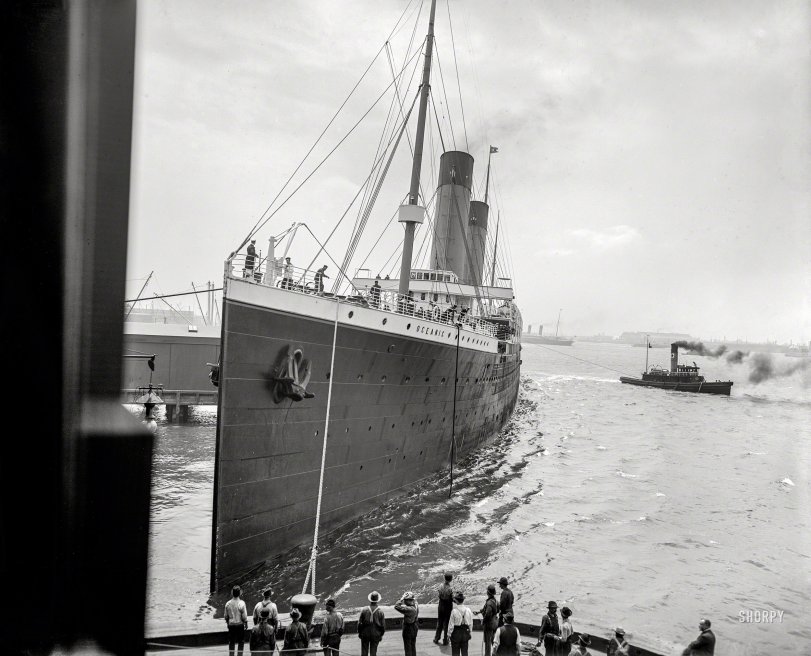


Framed or unframed, desk size to sofa size, printed by us in Arizona and Alabama since 2007. Explore now.
Shorpy is funded by you. Patreon contributors get an ad-free experience.
Learn more.

- Baldwin 62303
- Baldwin VO-1000
- Cold
- No expense spared
- Tough Guys
- Lost in Toyland
- And without gloves
- If I were a blindfolded time traveler
- Smoke Consumer Also Cooks
- Oh that stove!
- Possibly still there?
- What?!?
- $100 Reward
- Freeze Frame
- Texas Flyer wanted
- Just a Year Too Soon
- WWII -- Replacing men with women at the railroad crossing.
- Yes, Icing
- You kids drive me nuts!
- NOT An Easy Job
- I wonder
- Just add window boxes
- Icing Platform?
- Indiana Harbor Belt abides
- Freezing haze
- Corrections (for those who care)
- C&NW at Nelson
- Fallen Flags
- A dangerous job made worse
- Water Stop
Print Emporium
R.M.S. Oceanic: 1903

New York, 1903. "Docking a big liner -- R.M.S. Oceanic." 8x10 inch dry plate glass negative, Detroit Photographic Company. View full size.
On the bow
Much like today you will have a pilot and the master of the vessel on the bridge for docking and officers on the bow and stern for docking with one likely on the bridge as well assisting with the telegraph and log books. Here it looks like the Chief Officer is on the bow directing the seamen handling the lines, with one clearly at a box which likely contains a phone to communicate their progress to the bridge. The key things they would relay would be the time of first line on the dock, progress of the tie up and, later on, completion ("all fast, forward"). Amazing how much has changed, but also how little has changed in this industry.
Balance & Proportion
The Oceanic was such a beautiful ship. Ships built around 1900 were often an interesting and balanced mixture of what preceded them and the much larger ships that would follow just a few years later.
A lady in a class by herself
Oceanic was supposed to be the first of two sister ships, like the Teutonic and Majestic before her. But as it happened her planned twin (to be named Olympic) was abandoned in favor of the first of what would be the Celtic class. White Star referred to them as the Big Four. But the Oceanic, with no running mate, was probably the most popular and successful of their pre-war liners. After the Majestic, White Star adopted a novel approach to their business and decided to stop competing for speed records which involved enormous expense in both ship design and fuel consumption, often with the ships becoming outdated within just a few years. They instead decided to focus on the comfort of their passengers, in all three classes, while ensuring that their ships were fast enough to meet the needs of the traveling public, but no more. This proved to be a highly profitable business model. The Oceanic had a service speed of around 20 knots, which meant she could hold her own among the express liners, but her fuel consumption was a fraction of what the Atlantic greyhounds were burning. And her appointments were among the finest of the period. Charles Lightoller, one of her junior officers who would go onto fame in his own right, later referred to Oceanic as his favorite ship. He noted the incredible care and "spare no expense" attitude that evoked her interiors. The company, he observed, spent ₤500 just on the doors to her first class lounge!
Violet Jessup
Violet Jessup served as either stewardess or nurse on all three sister ships of this class (Titanic, Britannic and Olympic); she is best known for having survived the sinking of the first two and a collision of the Olympic with a British warship as well.
A mere rowboat compared to today's
I sometimes go to Chelsea Piers on the west side of Manhattan where they have pictures of the ships tied up during the WWI-WWII era when the piers were used to dock boats and not just as a gym. Off in the distance in the harbor can be seen modern cruise ships, which can't fit on the old piers. Modern cruise ships are longer than 1000 ft in length - leave aside cargo ships.
Lost 11 years later
At 705 feet long and 17,274 gross tons, the Oceanic, launched in 1899, was the largest liner afloat. But not for long. In April 1901, the White Star Line launched the Celtic at 700 feet and 21,000 tons. Oceanic served on the transatlantic route until the outbreak of World War I.
Oceanic,who had made her last voyage to New York in July, was commissioned as an "Armed Merchant Cruiser." The British Admiralty, with no experience in handling such large vessels, appointed Captain W. F. Slayter, RN, to command the ship. Meanwhile, Oceanic’s own captain Henry Smith was present on the ship. On Sept. 8, Oceanic was three miles off Foula Island (west of the Shetlands); Smith told Slayter that the ship was too close to the island, and was at risk of grounding. Smith was overruled by the naval captain, who insisted on a tight schedule. As a result, Oceanic was grounded on the Hoevdi Rocks, southwest of Foula. She was a total loss, and remained on the rocks until most of her was salvaged in 1924.
Charles Lightoller, the most senior surviving officer of Titanic, was serving as a lieutenant on Oceanic when she ran aground.
























On Shorpy:
Today’s Top 5